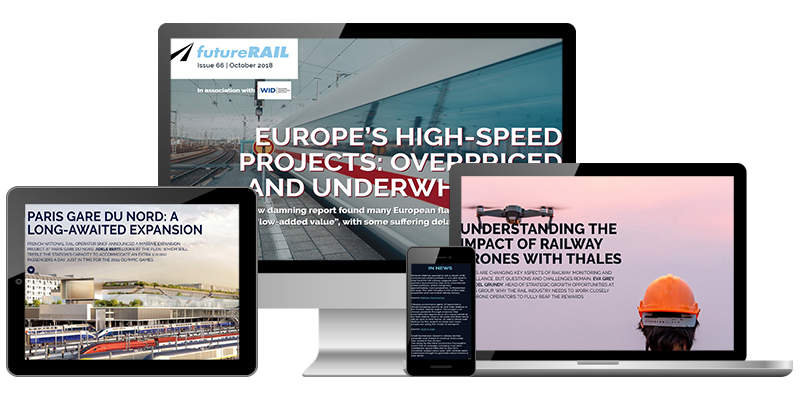
A recent in-depth analysis covering 5,000km of railways across six EU countries found that high-speed trains rarely reach their full potential, and in fact run much slower than previously expected. Future Rail magazine asks why European high-speed railways are falling short of their targets, and what can be done to boost efficiency across the network.
This issue also delves into the potential dangers of a Siemens-Alstom merger, analysing how the British rail market, and ultimately passengers, could end up paying dearly if two of the industry’s biggest players decide to join forces.
We also turn our attention to tech, an area where rail is often pushing boundaries. For instance, Crossrail tells us about its innovative use of virtual reality to train staff in a fully immersed environment, while Thales addresses the growing popularity of drones across the sector.
Finally, we profile the much anticipated expansion of Paris Gare du Nord, an ambitious project which will transform this station into a modern hub worthy of handling a large number of international visitors, while still keeping key elements of its original, timeless design.
Click here to read the latest rail industry news and analysis, and join the conversation on Twitter.
In this issue
Slow trains: the EU’s high-speed rail network dilemma
While high-speed rail projects continue apace in Asia, Europe lags behind, offering “low-added value”, according to a recent damning report from the European Court of Auditors. Ross Davies takes a look at what has gone wrong.
Read the article here.
Could an Alstom-Siemens merger kill off competition?
An investigation has been opened into the proposed merger of rail equipment giants Siemens and Alstom, after serious doubts were cast over the potential impact on market competition in the UK. Eva Grey reports.
Read the article here.
From London’s Deep Tube to Moskva Metro: the world’s most modern trains
Between Brussels’ autonomous fleets, New York’s passenger-centric design and London’s top-notch signalling, Eva Grey finds out which countries are leading by example and delivering some of the world’s most modern, efficient and reliable metro systems.
Read the article here.
Paris Gare du Nord: a long-awaited expansion
French national rail operator SNCF announced a massive expansion project at Paris Gare du Nord. Adele Berti looks at the plan, which will treble the station’s capacity to accommodate an extra 100,000 passengers a day, just in time for the 2024 Olympic Games.
Read the article here.
Understanding the impact of railway drones with Thales
Drones are changing key aspects of railway monitoring and surveillance, but questions and challenges remain. Eva Grey asks Joel Grundy, head of strategic growth opportunities at Thales Group, why the rail industry needs to work closely with drone operators to fully reap the rewards.
Read the article here.
Creating a train station in virtual reality with MTR Crossrail
The operator of London’s Elizabeth Line has developed a platform that allows trainee staff to hone their safety and security skills in a virtual train station. In this Q&A, MTR Crossrail finance director Andy King talks to Joe Baker about the benefits of this innovative approach to training, and how it could be expanded in the future.
Read the article here.
Next issue preview: Future Rail November
In the wake of the announcement that New York’s L train is preparing to take an 18-month hiatus for tunnel repairs, the residents of hip neighbourhood Williamsburg are scurrying to leave the area behind, disillusioned by the prospect of a commute without reliable public transport. The phenomenon made us ask: what are the social and economic consequences when urban rail disappears from an area, and at what cost?
Another transformation we got our eye on is the changing role of train stations, as more and more people are using their travel time to run errands, from business meetings to grocery collection.
We also consider the future of train guards on an increasingly digitised network, and delve deeper into the Joint Rail Data Action Plan to understand how open data could lead to improved mobile services for passengers.
Finally, on the brink of winter, we turn our attention inside the carriage to see how train companies should manage fluctuating temperatures that can, at their most extreme, pose a real danger to passengers.



